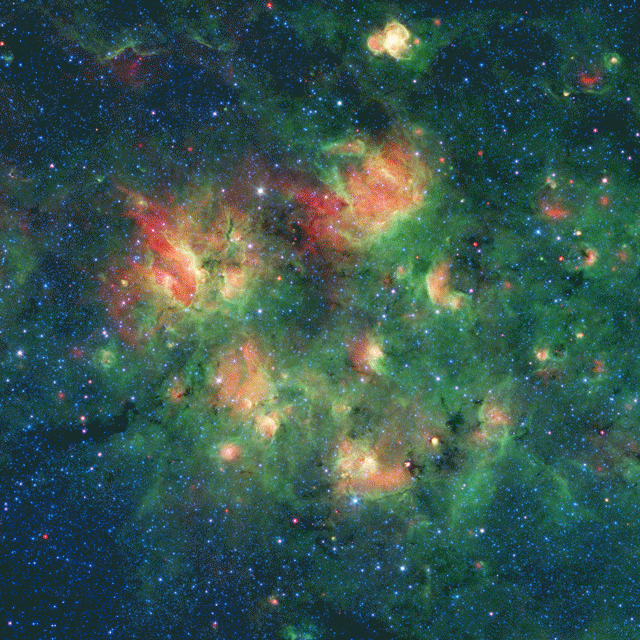
Multiple bubbles and bow shocks from young stars seen in this new infrared image from the Spitzer Space Telescope were recently identified as part of The Milky Way Project, a citizen science initiative on Zooniverse.org. The project enabled citizen scientists to look through images from Spitzer’s public data archive and identify as many of these sorts of cosmic bubbles as they could. More than 78,000 unique user accounts contributed, which enabled astronomers to publish a catalog of the bubble candidates that multiple citizen scientists had identified. The full Milky Way Project catalogs, which list a total of 2,600 bubbles and 599 bow shocks, are described in a paper published recently in Monthly Notices of the Royal Astronomical Society. This new infrared image from the Spitzer Space Telescope was made possible by this work; it enabled astronomers to know where to look. The image shows a cloud of gas and dust full of bubbles, which are inflated by wind and radiation from young, massive stars. Each bubble is filled with hundreds to thousands of stars, which form from dense clouds of gas and dust.
NASA said in a statement on September 30, 2019:
The bubbles are estimated to be 10 to 30 light-years across, based on what astronomers know about them and other cosmic bubbles. However, determining the exact sizes of individual bubbles can be difficult, because their distance from Earth is challenging to measure and objects appear smaller the farther away they are.
Flows of particles emitted by the stars, called stellar winds, as well as the pressure of the light the stars produce, can push the surrounding material outward, sometimes creating a distinct perimeter.
In an accompanying annotated image, yellow circles and ovals outline more than 30 bubbles.
This active region of star formation is located within the Milky Way galaxy, in the constellation Aquila (also known as the Eagle). Black veins running throughout the cloud are regions of especially dense cold dust and gas where even more new stars are likely to form.
Spitzer sees infrared light, which isn’t visible to the human eye. Many interstellar nebulas (clouds of gas and dust in space) like this one are best observed in infrared light because infrared wavelengths can pass through intervening layers of dust in the Milky Way galaxy. Visible light, however, tends to be blocked more by dust.
The colors in this image represent different wavelengths of infrared light. Blue represents a wavelength of light primarily emitted by stars; dust and organic molecules called hydrocarbons appear green, and warm dust that’s been heated by stars appears red.
Also visible are four bow shocks – red arcs of warm dust formed as winds from fast-moving stars push aside dust grains scattered sparsely through most of the nebula. The locations of the bow shocks are indicated by squares in the annotated image and shown close up in the accompanying detail images.

Bottom line: Citizen scientists identified a total of 2,600 bubbles and 599 bow shocks from young, hot stars. A new NASA Spitzer Space Telescope image shows one of these regions.
Source: The Milky Way Project second data release: bubbles and bow shocks











